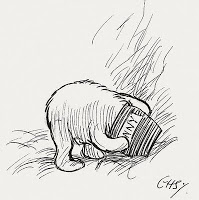 There’s a well-timed article on Boundless, a Christian webzine for students, entitled Lessons from a Bear of Very Little Brain: The Place of Children’s Literature in Education, what with me starting studying children’s literature this very week. Sam Torode speaks of how reading Winnie the Pooh was the most important thing he did in his four years of college (yes, it’s an American site, but don’t let that put you off!), and how he and a friend set up the A A Milne Society for the reading aloud of Winnie the Pooh.
There’s a well-timed article on Boundless, a Christian webzine for students, entitled Lessons from a Bear of Very Little Brain: The Place of Children’s Literature in Education, what with me starting studying children’s literature this very week. Sam Torode speaks of how reading Winnie the Pooh was the most important thing he did in his four years of college (yes, it’s an American site, but don’t let that put you off!), and how he and a friend set up the A A Milne Society for the reading aloud of Winnie the Pooh.
Here’s perhaps the heart of the articles:
Above all, the A. A. Milne Society taught us to take delight in literature, to read and listen for the sheer joy of it. Sadly, most English teachers possess a superhuman ability to make great literature seem dull (no small feat). Primarily, this is accomplished through various methods of critical analysis. By explaining the “meaning” of “texts,” reducing beautiful writing to abstract rules of grammar, and deciphering poetic symbolism as if it were mathematical code, English teachers transform living works of art into so many corpses waiting to be dissected. Such methods and systems do not only render literature dull; they are also counterproductive of true education. As James S. Taylor states in his study of the philosophy of education, Poetic Knowledge, “there can be no real advancement in knowledge unless it first begin in leisure or wonder, where the controlling motive throughout remains to be delight and love.”
This has always been my pet hate when studying literature. When taught and studied badly, the most wonderful and moving writing can have all its life and joy and true meaning sucked out of it. One of the reasons I’m so looking forward to studying children’s literature is because I love these books, and one of the reasons I’m nervous about it is because I don’t want the terrible vampire of loveless analysis.
However, I do feel the article might be in danger of overstating the affect of study, of over-romanticising the way books should be read. Critical analysis, properly done, deepens one’s appreciation of a piece of writing. Looking at, for example, the grammar of beautiful writing should be an exercise in discovering the skill that has gone into crafting something of beauty, and something that reveals new facets and nuances unseen.
An overly subjective view of literature can impoverish it just as much as an overly objective view of literature. Novels become mere literary chocolate bars for the gratification of the reader. If the subjective experience of the reader is glorified, then it is at the expense of the author and his work. Part of the proper humility we should have as readers is to seek to allow a work to speak as the author wrote it, rather than seeking to bend it to our own subjective whims. Writing is an act of communication, and reading an act of listening. The study of literature should be listening hard, and listening carefully. That musn’t become a dry exercise, but in our rush to avoid dry objectivism, we musn’t fall into the trap of chasing merely the emotional experience of reading to the neglect of the real content.
I really enjoy reading children’s literature. Somehow authors seem to feel much more free to write something unashamedly entertaining (or in the terms of Torode’s article, a thing of “leisure” as opposed to pre-packaged entertainments of computer games and television) when writing for children than for adults. Or rather, to make it unashamedly entertaining without making it a comedy – adult writers often seem to labour under the delusion that entertainment is not a serious business.
I’m not meaning to imply that children’s books are just simple pleasures compared to the real, grown-up meaty literature. To take an example, Chris Wooding‘s adult fantasy novels, The Braided Path trilogy, although painting a vivid world, are rambling and slightly dull. Although perhaps bigger, more “complex” stories in some ways, they both lack the discipline, focus and pace of his young adult books like The Haunting of Alaizabel Cray and Poison, and also are less thematically interesting. Haunting tackles themes of belief, hope and despair, at the same time as telling a roundly entertaining monster story, while Poison is a riff on fairytales and fantasy that explores questions of fiction, reality and freedom. I haven’t read the last book in the trilogy, but so far Wooding’s adult novels have yet to match the standard of his other works.
Philip Pullman made the claim that children’s literature is the area of fiction that is really “engaging with the big themes of literature” like life and death and love and loss, while adult fiction is caught up with Bridget Jones-style antics of “Does my bum look big in this?” Although that’s something of an unfair generalisation, literature for children and young adults is indeed often at least as bold, interesting and imaginative as that written for adults. I hope that as I study these books over the coming semester, I’ll keep the wonder and joy that are necessary for any serious study.



